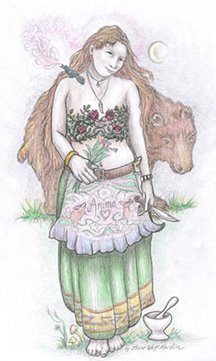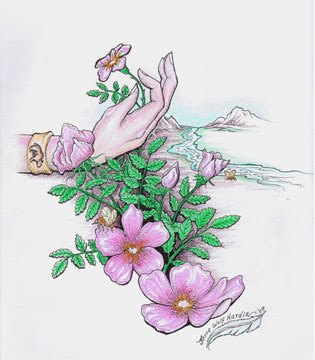
For the last week we've been receiving a fairly steady coating of snow, which is great because the SW can use all the moisture we can get. I will admit though, that it makes me long for spring and the arrival of new baby plants. But today, wandering about while checking out the sumach buds, I noticed a single silver finger peeking up through the snow. Digging down a bit, I discovered one my favorite plants, locally called Estafiate, happily growing in the cold and wet. Estafiate, one of the most common plants of the Gila, is one tough plant. Growing in near desert, mountains, grasslands and even under the snow, she seems to be able to survived most anything. Closely related to the oft-used Mugwort, Estafiate can be used nearly identically as long as you keep in mind that she's a bit stronger and certainly more bitter than her cousin. I've been using this plant primarily for wound healing and digestive upset lately, but it has a huge range of uses and is usually one of the most important medicines in any region where it grows.
I'm posting here an essay I wrote about Estafiate last Spring, and updating it with a few new observations.  Estafiate: The Grandmother Sage
Estafiate: The Grandmother Sage
by Kiva Rose
Artemesia spp.
Energetics: Stimulating/Sedating, Cold, Bitter & Pungent
Primary Actions: relaxing tonic, nervine, emmenagogue
They’ve come from all over the country to learn the medicine of this restored river canyon. On a guided plant walk through the lush green river woodland, they point to vines, twisting tree trunks and bright faced flowers, asking the name and use of each. The rich smell of cottonwood leaves and wild mints mingles with the ever-present desert undertone of sand and sage. They’re excited to learn the strange names of seemingly exotic plants, such as Scarlet Guara, Mexican Skullcap and Rocky Mountain Beeplant. One woman, an aspiring herbalist and new mother, asks me what the most important indigenous medicine was to the Natives. I look around, past the lithe willows and pink penstemons, on further past the hypnotic Sacred Datura and delicate Sego Lilly. Pointing at a sandy stretch away from the river, we walk over to a small, scraggly sagebrush-like weed. I pluck a single leaf and crush it between my fingers and offer it for all to smell. The pungent, sagey aroma wafts in the breeze, lighting up their surprised faces. Surely they expected a rare relic of the ancient rainforest. She is Estafiate, I say, the grandmother herb. In Russia they call her Zabykto, meaning forgetful, because she is so often forgotten.
Estafiate, while frequently overlooked, is nonetheless a powerful herb. A trickster plant taking many forms, those new to this shapeshifting desert native should forgive themselves any confusion in its identification. One of the first to come back in the Spring, it pushes up fat, feathery green leaves that provide welcome change to a landscape of predominantly cacti and yucca. As it matures, it grows into a lanky, silver-leafed shrub that’s almost lost among the bright flowers of May. It begins flowering around June, bearing inconspicuous yellow-green flowers on slim stalks. As Summer comes to its end, Estafiate begins to stoop, flower-heads often bent nearly to the ground. By this time, the plant has taken on a ragged, hag-like appearance and its leaves have mostly changed from several pronged hands to single pointed lances. If not watched closely, it can be hard to tell these three stages as the same herb. Yet once we get to know this sometimes elegant, sometimes ragged little plant, we’ll always recognize our Grandmother Sage.
Largely ignored by modern herbalists, Estafiate has long been a favorite among native peoples, gypsy healers, curanderas, yerberas and old-time “root doctors” for its broad range of uses and dependable availability. Its effects include the reproductive, digestive, urinary and and nervous systems. A stubborn emblem of folk medicine in the West, Estafiate’s shimmering silver-green foliage persists under the hot New Mexico summer sun long after all other greenery has withered and crisped. Cooling and bitter, this plant is rich in vitamins and minerals including vitamin B complex, necessary for a healthy nervous system and emotional stability, and also contains copious amounts of vitamin C, vitamin A, calcium, potassium, phosphorous and iron. It’s closely related to the ubiquitous Sagebrush as well as the infamous Wormwood, whose potent leaves were used to give Absinthe its characteristic deep green color.
A plant with hundreds of names, I’ve used Estafiate because of its Southwest association. This Spanish version is probably a corruption of the Aztec Iztáuhyatl, which translates to some approximation of: silver, fragrant plant of water. By “of water,” the Aztecs meant that this plant cured what they thought of as illnesses caused by too much water in the body such as epilepsy, leprosy and gout. It is also sometimes referred to in Spanish as Ajenjo, Romerrillo, Istafiate and Altamisa, its many names evidence of its renown in both Mexico and the Southwest. Well used and beloved among the Mayan, they call it Zizm and have their own cornucopia of uses for its leaves, flowers and root. It’s also known as Silver Sage, little Sagebrush, Prairie Sagewort and Western Mugwort– “plant for the mug”– a reference to its historical use in Europe as a flavoring in beer prior to the popularity of hops. Estafiate’s latin name Artemisia identifies it as an herb traditionally associated with the greek moon goddess, Artemis. The patroness of all things wild and free, it’s said she gave the plant her own name in thanks for the healing it provided her and the wild creatures in her care.
A plant traditionally associated with dreaming and magic by Europeans and indigenous Americans alike, a crown of its flowering tops was at one time worn by maidens on Midsummer’s Eve to call the fairies to their Solstice celebrations. Even now, it is quite common for small pillows to be stuffed with Estafiate to encourage sound sleep and vivid dreams. Held sacred since ancient times, it is burned as a pungent smudge or ceremonial smoke and is often used in the sweat lodge to purify and heal.
Called Women’s Sage by some Native tribes, Estafiate has traditionally been known as a women’s herb as well. It’s an effective emmenagogue, a tea or infusion encourages delayed or infrequent menses to return to their natural rhythm. A wonderful ally for women of all ages, it can also ease common PMS symptoms such as headache, depression, cramps and water retention. It may also be used externally as a poultice or oil on the pelvic area to soothe painful cramps. A daily tea encourages the slow dissolution of dermoid and ovarian cysts. And because of Estafiate’s gentle but thorough nervine and anti-depressent qualities, it can be safely used when a woman is feeling extra sensitive or vulnerable due to hormonal shifts such as the onset of menopause or puberty.
Often best known medicinally as an herb for the stomach, Estafiate lives up to its reputation as a bitter tonic and powerful stomachic. A tea or infusion of the leaves taken daily does an admirable job of preventing and treating food poisoning or traveler’s diarrhea. Its anti-inflammatory, bitter, antimicrobial and carminative actions also make it an extremely effective treatment for sluggish digestion, ulcerative colitis, gastritis, flatulence, dyspepsia, dysentery and almost any form of intestinal inflammation. The bitterness of the plant makes it tonic to the liver, stimulating bile secretion, reducing elevated liver enzymes and protecting the liver from a wide variety of toxins. Also a safe and mild diuretic, the herb can help with kidney or gallstones as well as intermittent cystitis. The plant is mildly yet broadly antimicrobial, and strongly inhibits outbreaks of herpes simplex I and II when used used either internally or topically as an oil or salve. It can also be used externally as a wash or salve on any kind of fungal infection, including thrush or ringworm. Estafiate is also anti-inflammatory and soothing to the nerves and is useful as an oil in the treatment of sciatica, wounds, burns, swellings, bruises, strains, muscle and joint pain. The fresh juice is especially helpful in eliminating the irritating itch of poison ivy and is also used as a bug repellent. An old-time remedy for arthritis and rheumatism, it can be taken internally as sips of tea, or externally as a bath or oil to ease chronically aching joints.
Estafiate is a gentle but powerful herb, and my favorite ways to use its healing qualities is through a tea, infusion, or an herbal vinegar. The tea and infusion are very bitter, so you might want to try drinking with a little lemon and honey. Vinegar works very well as an effective medium to extract the valuable vitamins and minerals as well as the other medicinal qualities of the plant in a concentrated form.
To make Estafiate vinegar, my participants and I fill, but don’t pack, a jar with fresh, chopped Estafiate. We cover the herb with apple cider vinegar (never use white vinegar), until the jar is full. We stir to release any trapped air bubbles, cap and label with the contents and date. We will have to let it sit for four to six weeks in a cool place away from sunlight, before they can strain and rebottle their vinegar. It will be used in salad dressings or soups, or be taken by the teaspoonful for its effects.
We gather together to continue our plant walk, our exploration of Southwestern plant-spirit medicine. Estafiate is a like a bent and silvery old woman, I tell my participants, alternately ignored, pulled from our gardens and tossed into bonfires. Yet she continues to bloom most everywhere one looks in New Mexico, gracefully offering up her stories, her lessons, her powerful remedies to those with the eyes and hearts to recognize her.
Tuesday, January 23, 2007
Artemesia Under the Snow
Posted by
Oakmoss Changeling
at
9:50 AM
![]()
Labels: Medicine Woman Materia Medica
Subscribe to:
Post Comments (Atom)
The Medicine Woman is glad you came...
All writings & posts (c)2007 Kiva Rose
All artwork & photographs (c) 2007 Jesse Wolf Hardin












1 comment:
My grandmother used to give me this when I was little for my stomach aches. Now, it is the only thing I trust when I have stomach problems. She gathers it from me in the mountains of Chihuahua and I make sure I have a stack of it at home. I didn't know about the effects it had on sleep, but know that I reflect upon it, I do sleep better and have more vivid dreams when I drink it. It is good to see this information online, people should know more about this.
Post a Comment